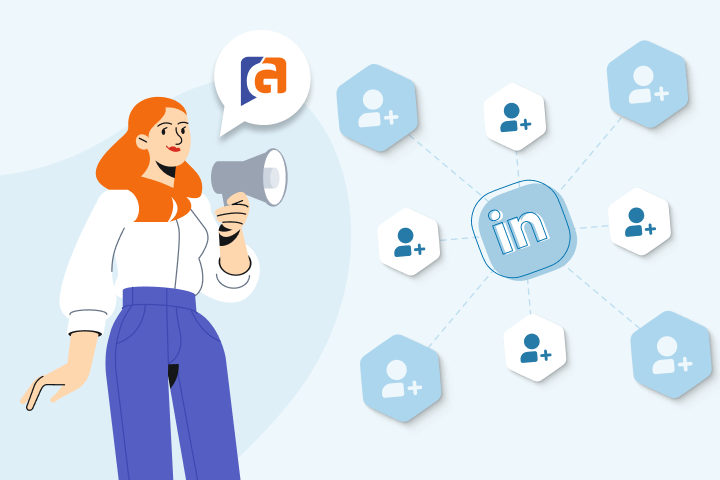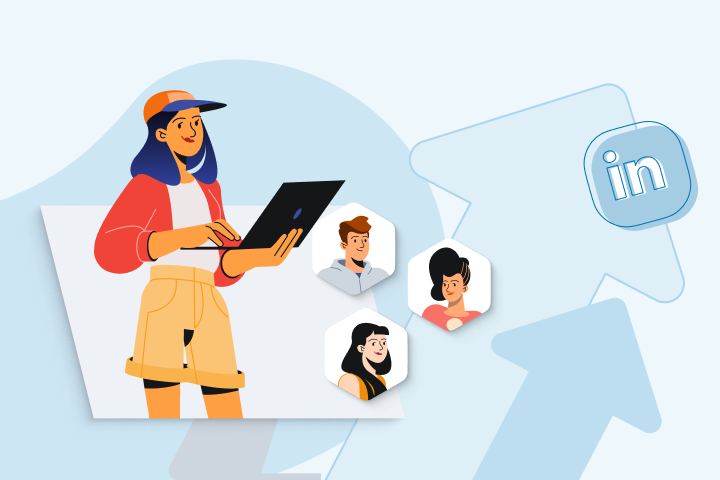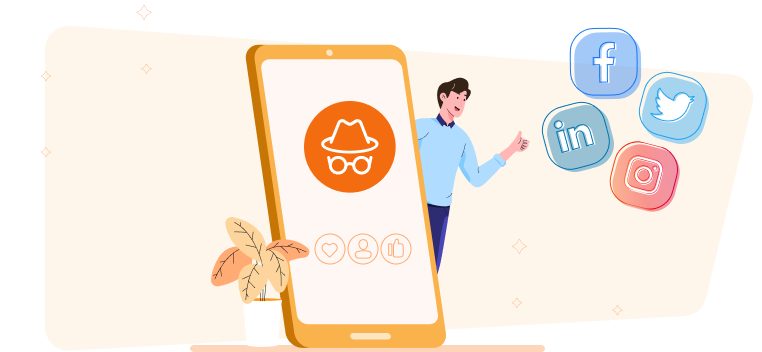How to Use (Organic) Social Media For Lead Generation
Social media is often considered a top-of-funnel marketing channel, but there are also strategies you can leverage to generate leads from your (organic) social media strategy.
So whether you’re trying to prove the ROI of social media to a boss or simply trying to improve your current social media strategy, here are a few different social media lead generation strategies you can leverage.
Prerequisites To Implementing a Social Media Lead Generation Strategy
If there are any weaknesses in your core social media strategy, you'll probably see a poor ROI from the social lead generation tactics we'll discuss below.
So here are a few of the prerequisites you can use to audit your current social media strategy before implementing lead generation optimizations.
Choose The Right Platforms
A common mistake social media marketers often make is trying to grow on all platforms at once.
However, social media growth is usually directly correlated with publishing quality and frequency, so you'll be splitting resources if you try to grow on multiple platforms simultaneously.
To help you choose the best platform to invest in, here are a few things to consider:
- How easy is it to grow on this platform?
- Is my audience on this platform?
- Are competitors thriving on this platform?
For example, TikTok might be one of the easiest platforms to grow on and will probably produce great engagement rates, but it probably won't drive high-quality B2B leads.
If you still need help selecting a social media platform, look at which platforms your competitors are investing in and gauge the quantity and quality of engagement.
For example, if you offer an online course platform, you could compare Kajabi's social media engagement across various platforms. You'll notice that even though the content strategies on both LinkedIn and Twitter are almost identical, the LinkedIn content consistently generates considerably more high-quality engagement:
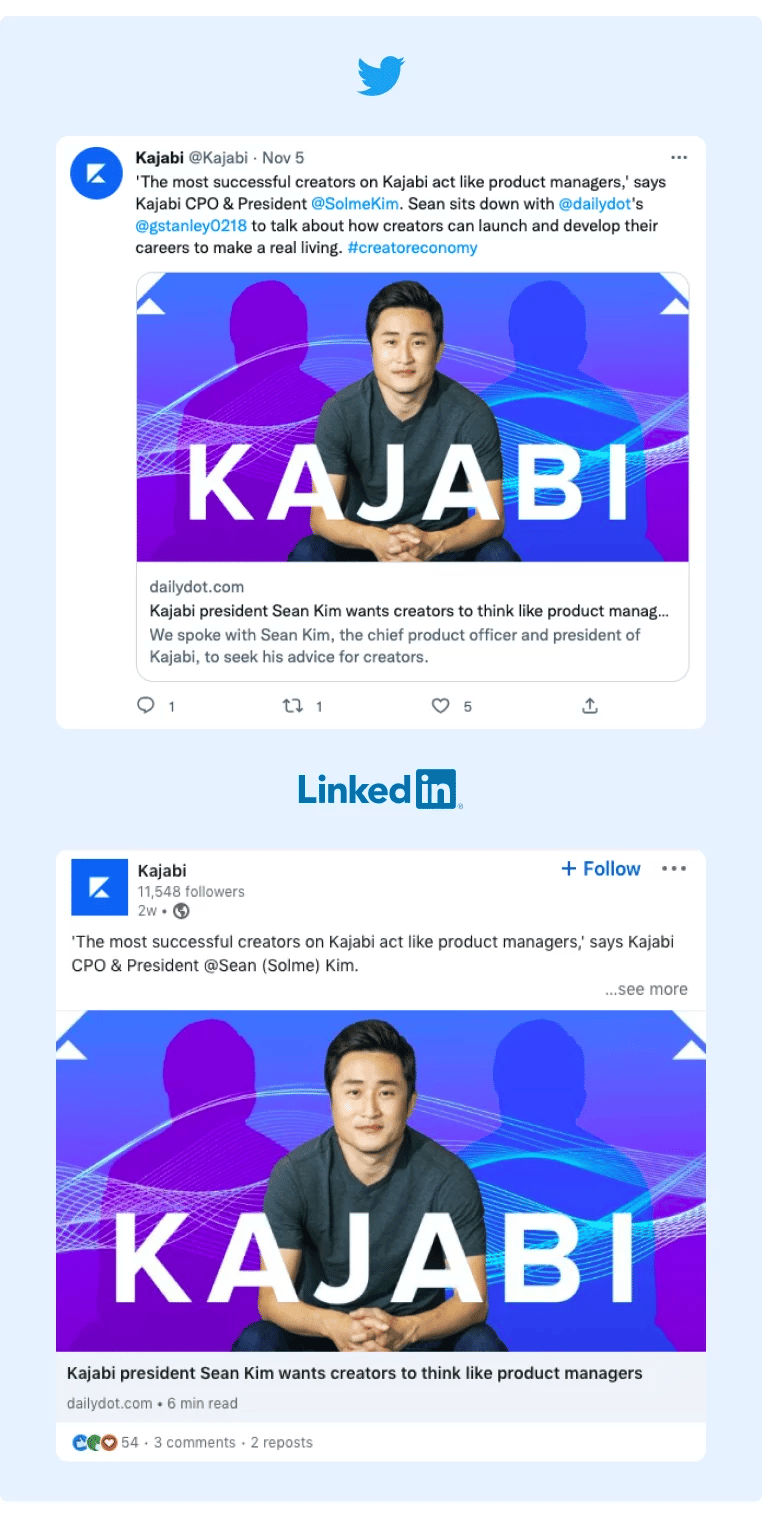
It's also a good idea to poke through the comments to see who engages with the content. For example, you can see in Kajabi's comments that the LinkedIn audience is clearly valuable:
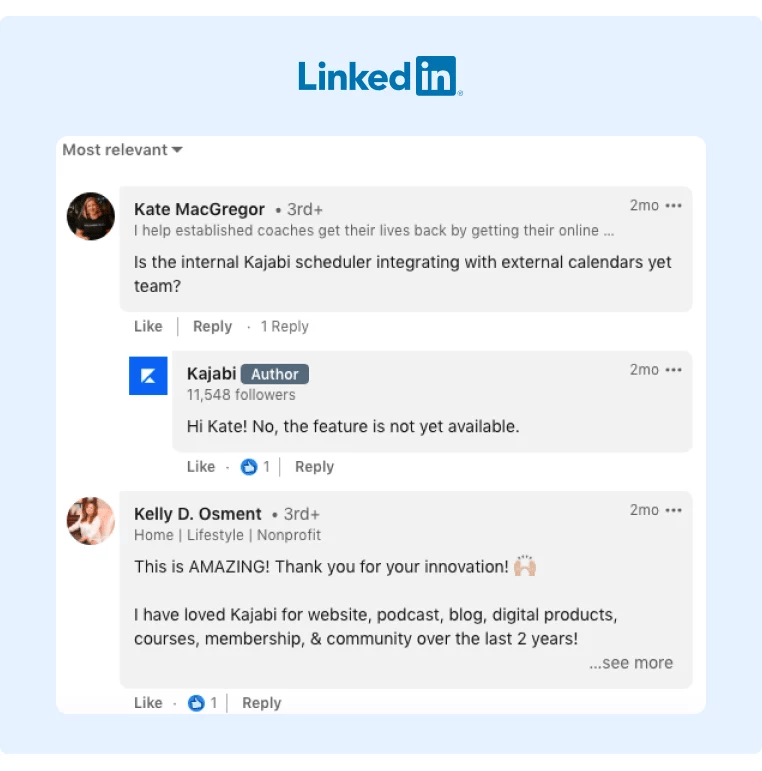
Another option is to email your audience and ask them which social media channels they use frequently.
Build Goodwill and Provide Value
The basis for any high quality B2B lead generation strategy is goodwill and a strong relationship with your audience.
A good rule of thumb is to have three or four high-value social media posts for every promotional post.
The caveat is that your value-add social posts can't be generic.
Many people create content designed to be a value-add yet doesn't actually provide any new insight that the audience hasn't already heard.
So before you publish a "value-add" post, ask yourself:
- Is this just a truth or best practice that most people already know?
- Will this content change my audience's perspective or help them execute something today?
- What about this post is remarkable?
Here's a post that takes a fairly common topic (content briefs) but repackages it in a way that makes it easy for the audience to swipe and implement today. It was rewarded with high engagement (200 plus comments and over 100 reshares):
Running through these questions will help you rethink your content strategy from the customer's perspective and improve the quality of your organic social media strategy, which will ultimately fuel your lead generation strategy.
Consistently Execute Best Practices
Long term growth is really just about executing the best practices consistently. So for each post you publish, use hashtags, add a clear CTA (call-to-action), and consistently publish several times per week.
It’s also important to follow the same branding guidelines so that your audience easily recognizes content from your brand.
If you want to see an excellent example of a company that consistently practices the basics, check out HubSpot’s LinkedIn page. You’ll see that each post is high-quality, matches the HubSpot branding, and engages with potential customers in the comments.
Monitor Competitors
If your competitors are heavily investing in a certain type of content format or style, there's a good chance that it's working.
So take some time each month or quarter to scroll through your competitors' social media pages and ask:
- What kinds of content are they posting (e.g., video, memes, text, etc.)?
- How often are they posting content?
- Which content receives the most engagement from your target audience?
- Which platforms have they grown the most on?
Now that you have the basic social media best practices in place, here's how to optimize your social media strategy to generate qualified sales leads.
Employee Advocacy
Social media users are more likely to engage with their friends' content than a random brand's content.
So use this to your advantage and ask your employees to share company content with their social network. You can even ask them to create their own posts about company initiatives.
This strategy is called employee advocacy, and it's an excellent way to accelerate engagement and even drive leads.
Think about it – you're much more likely to purchase a product recommended by a friend than a random stranger.
This post is a great example of employee advocacy in action:
Another benefit of employee advocacy is that it's a relatively inexpensive lead generation strategy, as you don't have to pay your employees to promote the company. In fact, employees are incentivized to promote the company and see it succeed because it makes their resume more impressive and might open the door to a raise if the company grows.
So does employee advocacy actually drive leads?
While attributing direct conversions to employee advocacy can be tricky, several companies have credited employee advocacy with significant sales growth.
For example, peer-to-peer CIO advisory firm WGroup implemented an employee advocacy program that created a $2 million sales pipeline in just three and a half years.
Similarly, managed IT service provider Magna5 implemented an employee advocacy program that drove 8% of the company's total sales.
If employee advocacy is a successful lead generation strategy, why doesn't everybody use it?
Implementing an employee advocacy program can be a logistical nightmare.
Most managers tackle the problem by sending mass emails or Slack messages with generic engagement requests ("Please go share this LinkedIn post with your followers!").
This strategy may work for the first few weeks, but employees ignore most engagement requests over time. Sending specific engagement requests to specific employees can help increase engagement rates, but most managers don't have time to do that.
So to help you improve employee engagement, we created a solution that:
- Makes it easy for managers to send personalized engagement requests to specific employees at scale
- Removes friction from the engagement process for employees and cuts down the time commitment to just five or ten minutes once per week
That solution is GaggleAMP.
Here's a quick overview of how it works:
Step 1: Select an engagement activity. GaggleAMP offers engagement activities for all major social media platforms, and each one specifies the action task (like, comment, share, etc.).
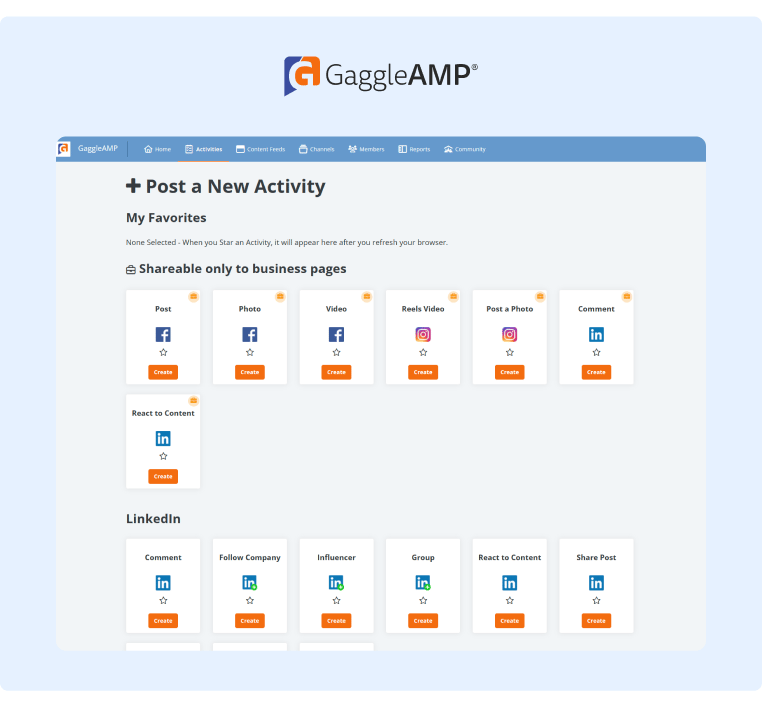
Step 2: Customize the engagement activity with specific instructions. You can add a link to a specific post, tell the employee exactly what to write, add a due date, and more. Giving employees specific instructions makes them more likely to engage because it decreases the decisions they have to make.
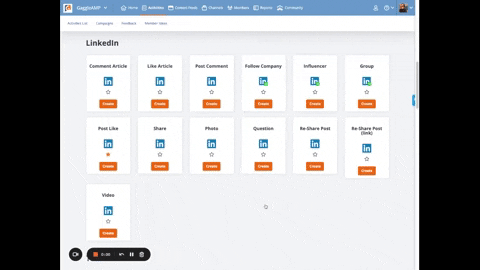
Step 3: Assign the engagement activity. Once the activity is created, you can assign it to a specific employee or group of employees.
Step 4: Employees complete the engagement activity. After assigning the activity, employees receive a notification and can log into the Gaggle to see a personalized list of engagement activities.

Step 5: Employees schedule the engagement activity. Rather than logging into a social platform each day, employees can schedule all of their engagement activities directly inside the Gaggle to publish at a future date/time.
Another reason why employees typically don't engage is that there is no accountability. So to acknowledge employees for their efforts, GaggleAMP also has a leaderboard that ranks employees by engagement. This way, you can reward employees for their engagement efforts.
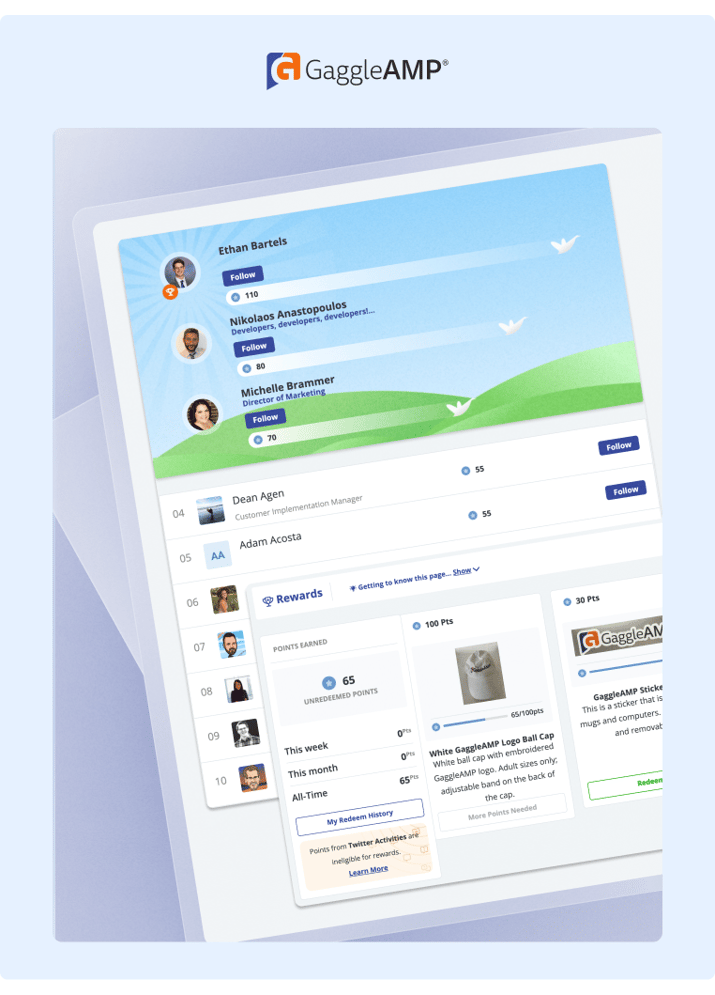
To see how GaggleAMP can help you engage your employees and encourage them to share more company content, schedule a demo today or jump into the platform for a free trial now!
Social Listening
Many social media users are actively looking for a solution like the one your company offers. The tricky part is finding those people.
Social listening solves this problem.
While you can manually search for keywords relevant to your product to find conversations, most social media managers don't have time to do this daily.
So instead, you can use a tool like Awario or BrandMentions, which allows you to track certain keywords and then sends alerts when those keywords are mentioned in conversations across various social media platforms.
For example, if you sell a basic email marketing or CRM platform, you might track a keyword like "email marketing tools" or "Hubspot alternative." Here's a great example of an excellent opportunity for a competitive brand to jump into the conversation:
Fellow marketers, I'm looking for a Hubspot alternative (Hubspot is overkill for me). What do you suggest for a reasonable price? Needs: email, automation, list management, workflows, integrations. Don't need: Sales funnel tools. #marketing #marketingautomation #contentmarketing
— Taryn M (@hermesgoddess) September 15, 2020
Testimonials and Customer Stories
People are much more likely to listen to purchase recommendations from friends than a social media ad.
So ask your current active users to send testimonials and case studies for you to post on social media. You can then tag them in the post, and there's a good chance that they'll share it with their audience.
For example, Laudable (which happens to be a testimonial platform) does a great job of using testimonials to promote their product on social media. Here's a post that showcases a testimonial from marketing influencer Rand Fishkin. Rand later shared it with his followers, which helped the brand generate high-quality engagement and visibility:
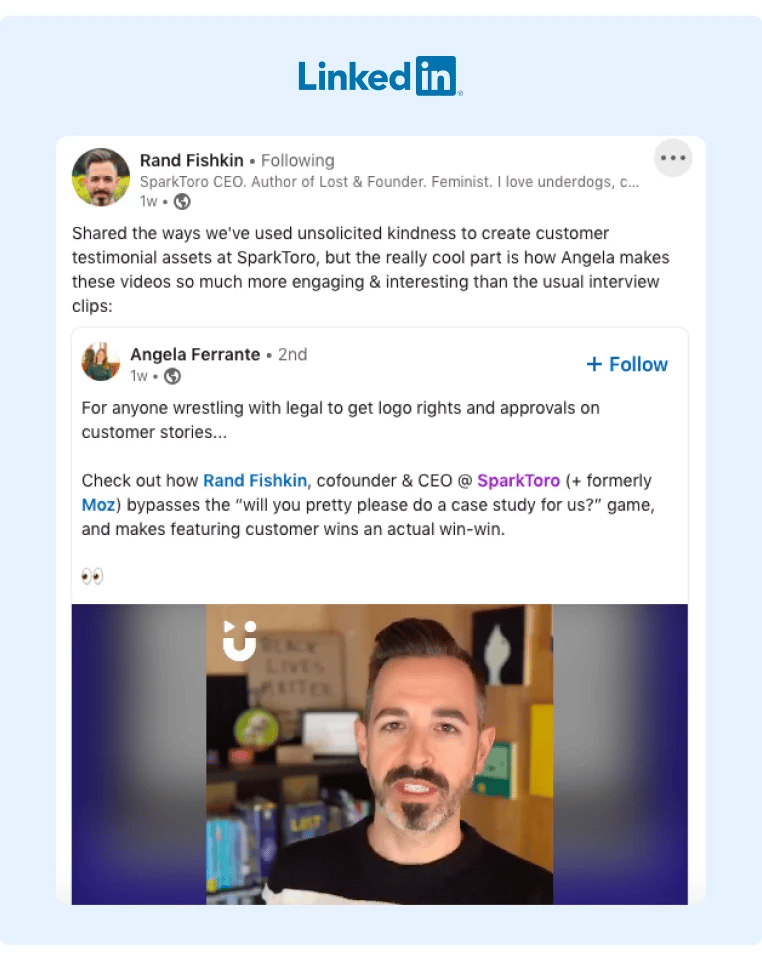
This post adds social proof to anyone considering the product and gets it in front of their target audience – B2B marketers.
Live Streaming
People are much more likely to trust your business and make a purchase if they have a chance to interact with the team. This is a key reason why demos are so effective at driving business.
The problem is that getting people on demos usually requires an extravagant sales funnel with lead magnets, landing pages, nurture sequences, and remarketing. Even if you get someone to sign up for a live demo, there's a good chance they'll cancel.
So one shortcut to immediately get in front of your customers and have a live conversation is live streaming on social media.
For example, Brendan Hufford recently hosted a live stream that discussed failure stories and scars from various agency owners.
Brendan offers a product that helps marketing agency owners grow their businesses, so this live stream idea was clever for a few reasons.
First, the angle was great. Anyone interested in hearing marketing agency challenge/failure stories is clearly a marketing agency owner that wants to grow their business (and is likely struggling with the process), so they're probably high-quality leads.
In addition, failure stories are a vulnerable topic, so it will help expedite the relationship-building process, and many of those viewers will likely trust Brendan by the end of the event.
Finally, he refused to record it so that people show up for the live event. While recording your events can give you some additional marketing material, it will probably reduce live participation.
Brand/Influencer Collaborations
Another great way to get in front of your ideal audience and drive leads is to simply partner with people and brands that already have your audience's attention.
There are several ways that you can do brand and influencer collaborations:
- Cross-promote each others' products with text/image/video posts
- Host a collaborative webinar or live stream where an executive from your team and another executive from a parallel/partner brand discuss key customer pain points
- Create a joint offer (e.g., bundle your products with another brand's products)
Here's a great example of how Leadpages and eWebinar partnered up to share how webinar users can build more effective landing pages. In this case, the two people hosting the webinar were simply executives at the respective companies.
Leadpages offers an integration with eWebinar, so if you're not sure who you should ask to collaborate with, look at your existing partners and ask them if they'd be interested in publishing a joint piece of content.
Another option is to look at the influencers who currently use your product. For example, pilates influencer Cassey Ho uses Kajabi to run her course, so they recorded several videos with her and shared them on social media.

Chatbot Campaigns
Another great way to drive new leads from social media is to create a system that automatically sends post commenters into a chatbot nurture sequence.
To do this, you can use a tool like Mobile Monkey or Chatfuel.
Below is an excellent example of how Codie Sanchez created a lead magnet and then pitched it to her social media followers.

This strategy is brilliant because the comments and retweets send positive engagement signals to social media algorithms, which helps boost its organic reach.
In addition, each person who comments is then sent an automated DM with the link. However, the link is to a landing page with the gated content, so she also gets your email address.
Therefore, she can then nurture leads through email marketing.
Retargeting Ads
Most people don't purchase on their first interaction with a brand, but if they have interacted with your brand once, there's a good chance that they're interested and might convert.
So to make the most of every interested person, run retargeting ads on social media.
To help you set up retargeting ads on each platform, here are the official guides:
- Retargeting with Facebook ads
- Retargeting with LinkedIn ads
- Retargeting with Twitter ads
As you set up your ads, you'll see that you can target very specific audiences. While it varies slightly from platform to platform, some of the audiences you can create include:
- People who visited your website
- People who visited a specific page (e.g., relevant whitepaper or contact page)
- People who have previously purchased
In addition to testing different audiences, you can also test different ad creatives.
For example, you can offer relevant content, promote a particular customer testimonial, or promote a special offer like a discount code.
Lead Gen Forms
If you’re advertising to a B2B audience, LinkedIn now offers Lead Gen Forms that make it easy to quickly earn a prospect’s contact information.
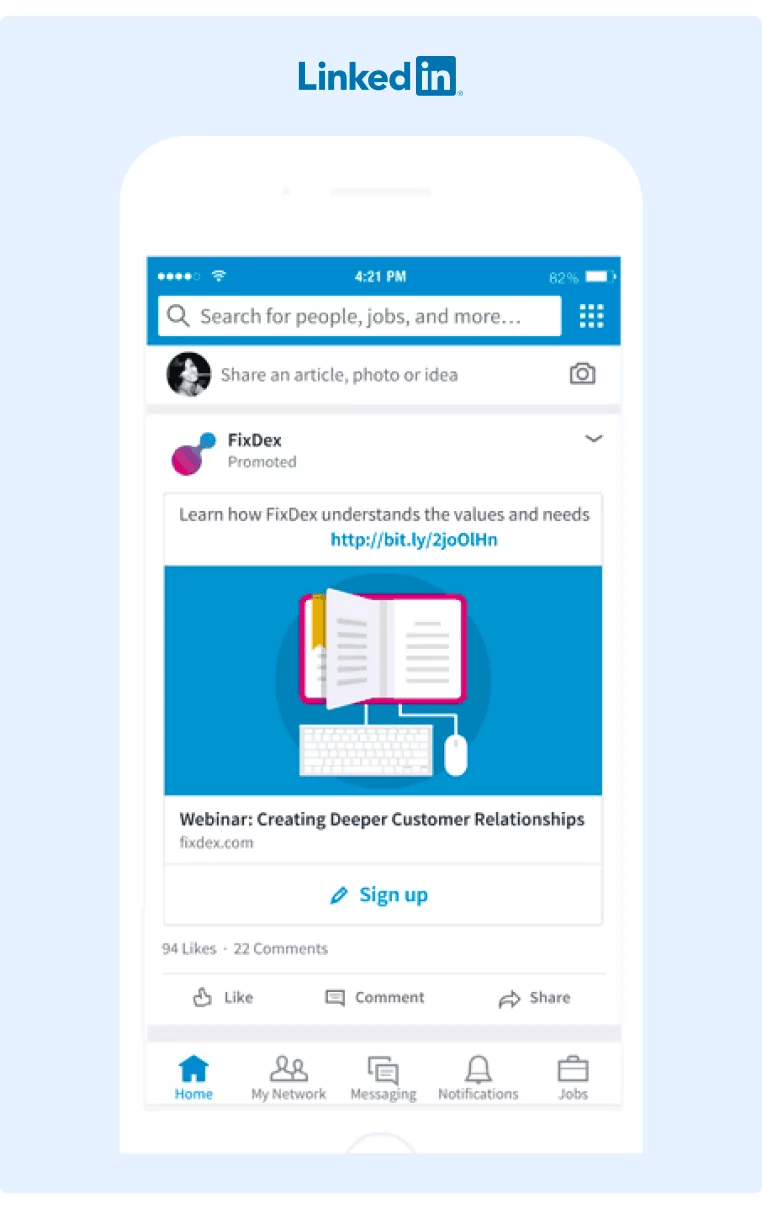
Lead gen forms are available for Message Ads and Sponsored Content, and you can even integrate responses directly with your CRM.
These forms tend to drive high conversion rates because LinkedIn auto fills all of the person's contact information for them, which reduces the effort on their part to submit the form.
Start Generating Leads From Social Media Today
Even though social media is primarily thought of as a channel to increase brand awareness, there are plenty of different ways you can turn it into a lead generation machine.
The key is learning how to engage with people in a personal manner, as the main use case of social media is personal interaction.
To help you crack that code, GaggleAMP makes it easy for you to supercharge your social media marketing strategy by leveraging your existing employees to promote content for you.
In fact, both of the following companies have found success using GaggleAMP:
- WGroup - Built a $2M sales pipeline with Employee Advocacy
- Magna5 - Leveraged employee advocacy to generate 8% of the company's total sales pipeline
To see for yourself how GaggleAMP can help you drive qualified leads, schedule a demo today.






